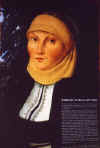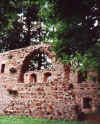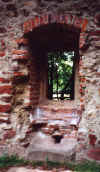|


| |
 |
Nimbschen is the village with the Cistercian convent
where Katherine von Bora lived (1509-1523); she and 8 other nuns, after
being convinced of the truth of Reformation teaching, escaped by night and
ended up in Wittenberg. Katherine married Martin Luther in 1525. Photo A
is a copy of a Cranach painting of Katherine von Bora in the outdoor
display case at the Nimbschen ruins. |
Facts and Photos
Walter von Loewenich provides a fairly complete biographical sketch of
Katherine von Bora's life (280-283). Additional information provided below comes
from the biography of von Bora by Haase.
 Katherine
von Bora, born on January 29, 1499, was the child of an aristocratic family in
the region south of Leipzig. Her mother died when she was four and her father
soon remarried. As child of 10 she was placed in the Cistercian Convent of
Nimbschen (photos B, right; and C, below) near Grimma. It was not uncommon for
young girls of noble families to be placed in convents, which generally included
a gift to the convent (similar to a wedding dowry). Apparently her family could
not afford the gift, but she was received there without it because two relatives
lived there. The abbess was related to her father; her mother's sister, who
later lived in the Luther household, was also a nun in the cloister. Katherine
was consecrated as a nun on October 8, 1515. Katherine
von Bora, born on January 29, 1499, was the child of an aristocratic family in
the region south of Leipzig. Her mother died when she was four and her father
soon remarried. As child of 10 she was placed in the Cistercian Convent of
Nimbschen (photos B, right; and C, below) near Grimma. It was not uncommon for
young girls of noble families to be placed in convents, which generally included
a gift to the convent (similar to a wedding dowry). Apparently her family could
not afford the gift, but she was received there without it because two relatives
lived there. The abbess was related to her father; her mother's sister, who
later lived in the Luther household, was also a nun in the cloister. Katherine
was consecrated as a nun on October 8, 1515.
 Luther's
teaching reached the isolated cloister via the nearby town of Grimma; much of
the population of the town, including men in the Augustinian monastery in
Grimma, were followers of Luther. Two relatives of the Augustinian prior lived
in the Nimbschen convent; it is likely that Luther's writings and teachings were
introduces via this connection. A group of nine nuns, including a sister of John
von Staupitz, head of the Augustinian monastery in Wittenberg when Luther
arrived there, decided to leave the cloister. After failed appeals for help to
their families, they turned to Luther, who enlisted the aid of a respected
citizen of Torgau, Leonhard Koppe, with business interests in Nimbschen. The
nine women escaped on the eve of Easter 1523 by hiding in Koppe's covered wagon
normally used for hauling herring barrels. A few days later they arrived in
Wittenberg, and Luther felt personally responsible for getting all of them
permanently settled. Return to their families was not possible, since all came
from Duke George's territory. Duke George shared the rule of Saxony with his
brother Elector Frederick. The brothers held opposite views of Luther, and
George was the swore enemy of Luther and his followers. Luther's
teaching reached the isolated cloister via the nearby town of Grimma; much of
the population of the town, including men in the Augustinian monastery in
Grimma, were followers of Luther. Two relatives of the Augustinian prior lived
in the Nimbschen convent; it is likely that Luther's writings and teachings were
introduces via this connection. A group of nine nuns, including a sister of John
von Staupitz, head of the Augustinian monastery in Wittenberg when Luther
arrived there, decided to leave the cloister. After failed appeals for help to
their families, they turned to Luther, who enlisted the aid of a respected
citizen of Torgau, Leonhard Koppe, with business interests in Nimbschen. The
nine women escaped on the eve of Easter 1523 by hiding in Koppe's covered wagon
normally used for hauling herring barrels. A few days later they arrived in
Wittenberg, and Luther felt personally responsible for getting all of them
permanently settled. Return to their families was not possible, since all came
from Duke George's territory. Duke George shared the rule of Saxony with his
brother Elector Frederick. The brothers held opposite views of Luther, and
George was the swore enemy of Luther and his followers.
Katherine's prospects looked good at first, when the son of a Nuremberg
patrician, visiting Melanchthon, fell in love with her and promised to return.
Luther wrote to the man in October 1524, urging him to hurry or someone else
might claim her. Apparently his family opposed his choice of a penniless ex-nun,
and so nothing more came of their relationship. The other suitor mentioned in
Luther's letter was a theologian at the university, Kaspar Glatz. Katherine did
not want to marry Glatz, and in desperation turned to another of Luther's
colleagues, Nicolas von Amsdorf. She asked him to convince Luther not force her
to marry Glatz against her will; she would consider others, including von
Amsdorf or Luther himself, but never Glatz. This may have been the turning point
in Martin and Katherine's relationship, for he originally disliked her and found
her arrogant.
Scholars agree that theirs was not a love match, and that Luther's decision
to marry was based primarily on his conviction that he himself practice what he
had preached. He also once stated that he married "to please my father and
spite the pope." His choice of Katherine also solved the problem of what do
to about the runaway nun with a mind of her own. |
